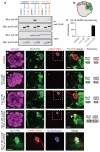Teneurins instruct synaptic partner matching in an olfactory map
- PMID: 22425994
- PMCID: PMC3345284
- DOI: 10.1038/nature10926
Teneurins instruct synaptic partner matching in an olfactory map
Abstract
Neurons are interconnected with extraordinary precision to assemble a functional nervous system. Compared to axon guidance, far less is understood about how individual pre- and postsynaptic partners are matched. To ensure the proper relay of olfactory information in the fruitfly Drosophila, axons of ∼50 classes of olfactory receptor neurons (ORNs) form one-to-one connections with dendrites of ∼50 classes of projection neurons (PNs). Here, using genetic screens, we identified two evolutionarily conserved, epidermal growth factor (EGF)-repeat containing transmembrane Teneurin proteins, Ten-m and Ten-a, as synaptic-partner-matching molecules between PN dendrites and ORN axons. Ten-m and Ten-a are highly expressed in select PN-ORN matching pairs. Teneurin loss- and gain-of-function cause specific mismatching of select ORNs and PNs. Finally, Teneurins promote homophilic interactions in vitro, and Ten-m co-expression in non-partner PNs and ORNs promotes their ectopic connections in vivo. We propose that Teneurins instruct matching specificity between synaptic partners through homophilic attraction.
Figures





References
-
- Dickson BJ. Molecular mechanisms of axon guidance. Science. 2002;298:1959–1964. - PubMed
-
- Zipursky SL, Sanes JR. Chemoaffinity revisited: dscams, protocadherins, and neural circuit assembly. Cell. 2010;143:343–353. - PubMed
-
- Luo L, Flanagan JG. Development of continuous and discrete neural maps. Neuron. 2007;56:284–300. - PubMed
-
- Komiyama T, Luo L. Development of wiring specificity in the olfactory system. Curr Opin Neurobiol. 2006;16:67–73. - PubMed
Publication types
MeSH terms
Substances
Grants and funding
LinkOut - more resources
Full Text Sources
Other Literature Sources
Molecular Biology Databases
Research Materials

